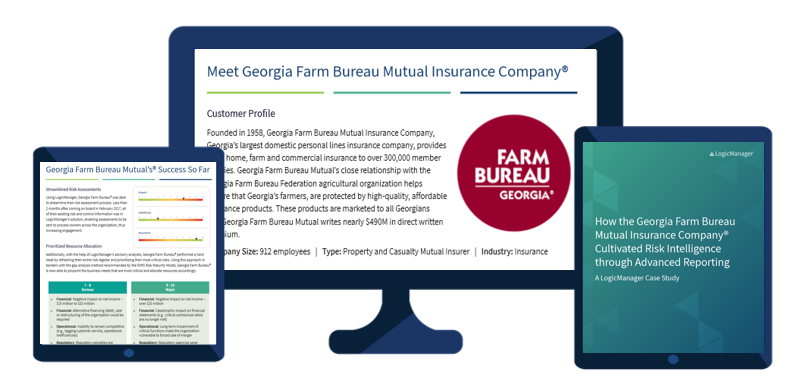Risk Management for Insurance Companies
[How To & Process]

Overview: Risk management in the insurance business is a bit of a head-scratcher. On one hand, insurance companies are selling what many people consider to be a risk mitigation. On the other, insurance companies themselves face a variety of risks they need to mitigate.
Let’s briefly consider a misconception about insurance as it pertains to risk management: Too often, people think insurance is a sufficient, catch-all control activity. But while insurance is a perfect way to protect a business from many risk scenarios, there are other scenarios insurance just can’t cover. Oftentimes, risk insurance does not cover the core competencies of a business.
Insurance companies can “self-insure,” or purchase coverage from a reinsurer, but this doesn’t ensure all of the company’s risk is accounted for. One of the biggest values an insurance company provides is customer service for those who need to submit a claim. If customers consistently have poor customer service experiences, they’re likely to share their stories on social media, tarnishing the company’s reputation and leading the company to fall behind their competition.
Free Download: Georgia Farm Bureau Mutual Insurance Company® Case Study

Learn how the farm bureau transformed the reputation and value-add of their risk management department by leveraging LogicManager’s software. Fill out the form below to download your free ebook.
How Can Insurance Companies Benefit from Risk Management?
According to a study by the National Association of Insurance Commissioners (NAIC), core risks in the insurance business include “underwriting, credit, market, operational, liquidity risks, etc.” Given this wide variety of concerns, there is a tremendous opportunity for risk management in insurance companies to make a positive impact.
To return to the customer service example above, let’s look at how enterprise risk management could help:
- Risk management involves identifying, assessing, and mitigating risk. The beauty of a well-implemented risk management program is that it’s built on a foundation of standardized risk assessments to help companies prioritize their risk based on its potential impact. Naturally, this process will surface risks that will impact the business’s core competencies.
- For an insurance company, customer service would inevitably come to the forefront of a risk assessment. To address this risk, the insurance company could take steps to integrate incident management and risk management. Most companies have a way to track incidents like customer complaints, but many do not have a way of categorizing, prioritizing, and escalating incidents across teams. Risk management in the risk insurance business helps centralize and identify trends in customer feedback.
- From there, insurance companies can implement controls to address those trends, such as hiring more customer service reps to resolve long wait times or implementing call screenings to identify less-than-helpful interactions.
Administer standardized, comparable, and actionable risk assessments by following the steps in our eBook, “5 Steps to Better Risk Assessments.”
Improving customer service is only one example of how insurance companies can leverage risk management. A fully integrated enterprise risk management program can help insurance companies develop proactive mitigation activities to protect the core of their business.
Risk Management in Insurance Companies Ensures Compliance
Insurance companies operate under the increased scrutiny of an ever-changing regulatory environment. Risk managers are expected to fully understand how changes at the federal and state-level impact their organization, as well as meet customer expectations for substantial coverage with fair requirements and claims processes.
The NAIC’s expanded Own Risk and Solvency Assessment (ORSA) requirement is just one example of a changing regulation designed to accommodate regulator and consumer expectations. ORSA is defined as “an internal process undertaken by an insurer or insurance group to assess the adequacy of its risk management.”
ORSA goes beyond the SEC disclosure requirements that have universal applicability. It requires firms to “analyze all reasonably foreseeable and relevant material risks…that could have an impact on an insurer’s ability to meet its policyholder obligations.”
The minimum threshold for an ORSA program requires yearly analysis of all material risks. Companies must prove risk assessments have been undertaken at the organizational level where the risk activity takes place, not just at the senior management level. Organizations ensure this occurs by setting a “tone from the top.”
To determine how well your organization’s risk management program meets regulatory and consumer demands, including ORSA requirements, we encourage you to take the Risk Maturity Model. Recommended by the NAIC and Institute of Internal Auditors, this free, 30-minute assessment benchmarks the strength of your risk management program and enables you to identify areas that need the most improvement.
Take a more detailed look at ORSA and how it affects insurance organizations by downloading our eBook with steps to ORSA compliance.
ORSA compliance alone can be a major risk management challenge without a connected ERM solution and risk management information system that consolidates information. When any manager can evaluate risks in his or her own sphere of responsibility, however, it’s very easy to “roll” assessments up to the next level. Reporting, whether for annual ORSA assessments or a board meeting, becomes a simple matter of presenting information that already exists in the system.
Examples of Risk Management in the Insurance Sector
Depending on emerging threats, professionals in the insurance sector face a wide variety of risks. Let’s take a look at some examples of what those risks might be (and what to do about them):
Example #1: Property damage
Insurance companies are often concerned with protecting their clients’ physical assets, including their brick and mortar properties. While natural disasters and other events may not destroy property entirely, they always pose a significant threat to a business’ ability to operate normally.
Mitigation options:
- Invest inadequate insurance coverage
- Implement strategic controls for prevention
- Develop a foolproof Business Continuity Plan that is proactively communicated with your entire organization
Example #2: Data breaches
There’s no question that businesses are relying more on technology today than ever before, meaning everyone is more susceptible to the risks associated with technology. Cybersecurity threats and ransomware attacks in recent years have skyrocketed, and data hacks have impacted businesses of all industries and sizes.
Mitigation options:
- Conduct intuitive and objective IT risk assessments
- Align policies and procedures to best-practice frameworks and regulations like ISO, NIST, COBIT, GDPR, CCPA and more
- Take a holistic approach to managing IT risk by engaging departments across the enterprise
Example #3: Product or service issues
When customers feel that their product did not meet expectations, challenges and risks are inevitable. So how do you prevent those risks from materializing into a more serious offense like a lawsuit?
Mitigation options:
- Invest in professional liability insurance
- Implement ERM software into your organization to prevent negligence claims
- Conduct vendor due diligence to prevent third party providers from producing products or services that don’t meet your organization’s standards
Example #4: Human capital costs
Employees pose a significant amount of risk to any business. Human needs and how they make decisions can directly impact a company’s wellbeing.
Mitigation options:
- Invest in workers’ compensation insurance
- Focus on protecting your organization from liability claims by investing in enterprise risk management software
- Conduct mid-year reviews (at the minimum) to determine where to invest more time and where to scale back resources
Insurance Risk Management Software
When working in the insurance industry, there is so much data collected that’s related to risk insurance policies, claims, renewals and physical assets. The problem that many insurance professionals find is that this data must be consolidated and easily accessible so that communication between the organization and its broker is seamless.
With so many different people being involved in this process, the workflows need to be efficient to make sure everything runs as smooth as possible. Reporting everything within your insurance business needs to be a detailed yet effective process. It’s a big job, but LogicManager’s insurance risk management software makes it easy.
- Our software helps risk managers identify insurance risk and then manage and monitor risks within the workplace, all while also creating comprehensive leadership reports.
- Without an automated risk management information system in place, collecting, tracking and reporting on insurance risk data is time consuming and inefficient.
- Our insurance risk management software can accelerate your insurance risk program by automating your processes and breaking down departmental silos.
In Summary: Risk Management in the Insurance Business
The insurance industry will likely face a changing federal regulatory landscape in the years ahead. Multiple regulatory influences at the state, federal and international levels continue to present significant challenges for the industry; the effect of Dodd-Frank on insurance companies remains uncertain, and how to classify insurance companies as systemically important financial institutions (SIFIs) still requires clarification. This is only a short list of items creating uncertainty in the insurance industry. Risk management for insurance companies enables insurance companies to succeed among this uncertainty by anticipating and addressing a wide variety of change before risks materialize.
Frequently Asked Questions
What role does insurance play in a risk management plan?
A company’s risk management approach is typically designed to prioritize the organization’s most significant risks, identify the potential impact of those risks and develop strategies to mitigate or eliminate them. This creates an insurance policy in the event that they occur.
What risk management techniques are used in insurance?
One example of a popular insurance risk management technique is a reserve fund. A reserve fund is created by using a percentage of all the premiums being collected. The fund will be used to pay out claims on behalf of people who have been impacted by an event.
What is the difference between risk management and insurance?
Risk management is a proactive process of planning and providing for a variety of risks, such as financial losses, reputational damage or operational disruptions. It can be compared to insuring against damages or losses that might occur in the future by taking preventive action now.
In contrast, insurance is an economic agreement between two parties where one party agrees to pay for damages from specified events below certain thresholds at predetermined intervals in exchange for periodic payment by the other party.
